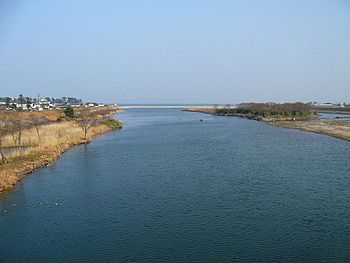Hino River facts for kids
Quick facts for kids Hino River |
|
|---|---|

Hino River near Yonago, Tottori Prefecture
|
|
| Country | Japan |
| Physical characteristics | |
| Main source | Mount Mikuni and Mount Dōgo, Tottori Prefecture 1,004 metres (3,294 ft) |
| River mouth | Miho Bay, Sea of Japan 0 m (0 ft) |
| Length | 77 kilometres (48 mi) |
| Basin features | |
| Basin size | 870 square kilometres (340 sq mi) |
The Hino River (called Hinogawa in Japanese) is a very important river in the western part of Tottori Prefecture, Japan. It starts high up in the mountains and flows all the way to the sea. Many people in the area rely on its water for their daily lives.
Contents
What is the Hino River?
The Hino River is one of the biggest rivers in Tottori Prefecture. It is about 77 kilometers (48 miles) long. That's like driving from one end of a city to another! The river begins its journey in the mountains and flows through different towns before reaching the Sea of Japan.
Where Does the Hino River Start?
The Hino River starts in the high mountains of southern Tottori Prefecture. Its source is near Mount Mikuni and Mount Dōgo. These mountains are quite tall, with Mount Mikuni reaching about 1,004 meters (3,294 feet) high. Imagine water trickling down from such a height, gathering into a stream, and then becoming a powerful river!
Where Does the Hino River End?
After flowing for many kilometers, the Hino River finally empties into Miho Bay. Miho Bay is part of the larger Sea of Japan. The river's journey ends near the city of Yonago and the town of Hiezu. This is where the fresh river water mixes with the salty ocean water.
How Does the River Flow?
When the Hino River first starts, it flows generally towards the east and northeast. As it moves through the town of Kofu, it makes a turn. From there, it flows mostly towards the north and northwest until it reaches the sea. This winding path helps the river collect water from a large area.
Why is the Hino River Important?
The Hino River is very important for the people living in Tottori Prefecture. It provides water for many different uses.
Water for People
About 60,800 people use the water from the Hino River every day. This water is used for drinking, cooking, and washing. It's amazing to think how many people depend on this one river for their basic needs!
Water for Farming
The river's water is also used to irrigate farms. Irrigation means supplying water to crops so they can grow. Farmers in the area grow rice and other vegetables, and the Hino River helps them keep their fields watered. This is crucial for producing food for the region.
Water for Industry
Some factories and businesses in the area also use water from the Hino River. They might use it for cooling machinery or for cleaning processes. The river supports the local economy by providing this essential resource.
Nature Around the Hino River
The area around the Hino River is home to many plants and animals. The river itself is an important habitat for fish and other aquatic creatures.
River Animals
Many types of fish live in the Hino River. These include common river fish as well as some unique species. Birds also visit the river to catch fish or to rest during their long migrations. You might see ducks, herons, or even kingfishers near the water.
River Plants
Along the banks of the Hino River, you can find various plants. These plants help to keep the soil from washing away and provide food and shelter for animals. The river's ecosystem is a delicate balance of living things.
Protecting the Hino River
Because the Hino River is so important, people work hard to protect it. This means keeping the water clean and making sure there's enough water for everyone and for nature.
Keeping the Water Clean
Efforts are made to prevent pollution from entering the river. This includes treating wastewater from homes and factories before it goes into the river. Keeping the water clean is vital for the health of the people and the environment.
Managing Water Levels
Sometimes, there can be too much rain, causing floods. Other times, there might not be enough rain, leading to droughts. River managers work to control the water levels using dams and other structures. This helps to prevent disasters and ensure a steady supply of water.
Images for kids


